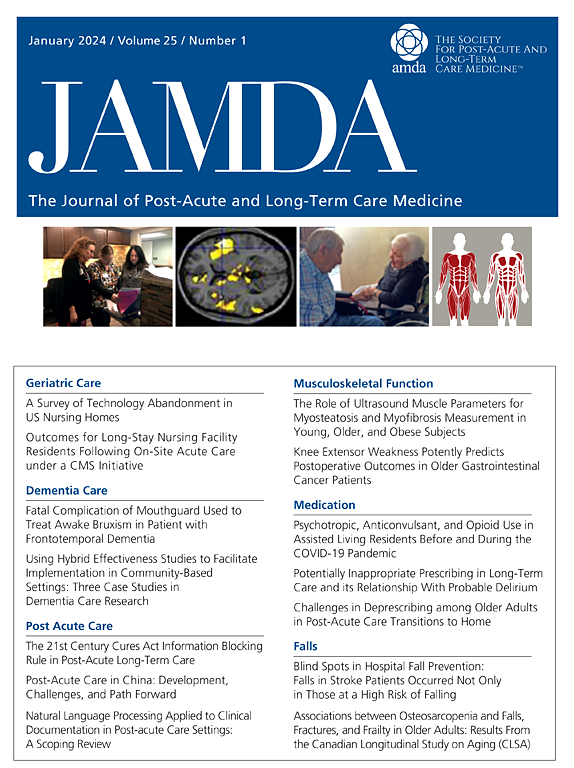Emerging Digital Technologies Used for Fall Detection in Older Adults in Aged Care: A Scoping Review
IF 3.8
2区 医学
Q2 GERIATRICS & GERONTOLOGY
Journal of the American Medical Directors Association
Pub Date : 2024-11-01
DOI:10.1016/j.jamda.2024.105330
引用次数: 0
Abstract
Objective
To explore a comprehensive overview of digital technologies used for fall detection in older adults, categorizing the types, functions, and usability of these systems.
Design
A scoping review was conducted to search across 5 databases [Embase, Medline (OVID), CINAHL, Coherence and IEEE Explore] from January 2013 to September 2023.
Setting and Participants
Studies in older adults living in nursing homes, care homes, residential homes, respite care homes, and all skilled and ambulatory care facilities (without context restrictions).
Methods
This review followed the 6 methodological stages: (1) identification of research question; (2) identification of relevant studies; (3) study selection; (4) charting the data; (5) collating, summarizing, and reporting the results; and an optional stage, (6) consulting with stakeholders regarding findings to explore pivotal concepts in emerging technology usage in long-term care for falls detection among older people. Data were extracted and categorized based on the Preferred Reporting Items for Systematic Reviews and Meta-Analyses extension for Scoping Reviews (PRISMA-ScR) guidelines.
Results
A total of 73 studies met the inclusion criteria. Four main categories of fall detection technologies were identified: motion and sensor technologies, imaging and visual systems, environmental sensors, and robotic and autonomous systems. Commonly used devices: wearable accelerometers, gyroscopes, infrared array sensors, and smart carpet pressure sensors. Data storage methods were wearable devices, cameras, and floor-mounted sensors. Communication technologies included Bluetooth, Wi-Fi, and GPS, and notification methods ranged from alarms and SMS to cloud communications. Various health care response teams, including caregivers, health care providers, and emergency services, were integral to the fall detection systems.
Conclusions and Implications
Most studies primarily focus on fall detection; however, we recommend further clinical research to emphasize both fall detection and, more importantly, fall prevention (both primary and secondary). Investigating the effectiveness of fall prevention technologies in real-world settings will be crucial for enhancing the safety and quality of life of the aging population.
用于老年护理中老年人跌倒检测的新兴数字技术:范围审查。
目的探讨用于老年人跌倒检测的数字技术的综合概况,对这些系统的类型、功能和可用性进行分类:设计:从 2013 年 1 月到 2023 年 9 月,在 5 个数据库(Embase、Medline [OVID]、CINAHL、Coherence 和 IEEE Explore)中进行了范围综述:研究对象:居住在疗养院、护理院、养老院、临时护理院以及所有专业和非卧床护理机构的老年人(不受环境限制):本综述遵循 6 个方法阶段:(1)确定研究问题;(2)确定相关研究;(3)选择研究;(4)绘制数据图表;(5)整理、总结和报告结果;以及一个可选阶段,即(6)就研究结果咨询利益相关者,以探索在长期护理中使用新兴技术检测老年人跌倒的关键概念。数据的提取和分类依据的是《系统综述和荟萃分析的首选报告项目》(Preferred Reporting Items for Systematic Reviews and Meta-Analyses extension for Scoping Reviews,PRISMA-ScR)指南:共有 73 项研究符合纳入标准。共确定了四大类跌倒检测技术:运动和传感器技术、成像和视觉系统、环境传感器以及机器人和自主系统。常用设备:可穿戴加速度计、陀螺仪、红外阵列传感器和智能地毯压力传感器。数据存储方法包括可穿戴设备、摄像头和安装在地板上的传感器。通信技术包括蓝牙、Wi-Fi 和 GPS,通知方法包括警报、短信和云通信。各种医疗响应团队,包括护理人员、医疗服务提供者和急救服务,都是跌倒检测系统不可或缺的组成部分:大多数研究主要侧重于跌倒检测;但是,我们建议进一步开展临床研究,既要重视跌倒检测,更重要的是要重视跌倒预防(包括初级和二级)。调查防跌倒技术在实际环境中的有效性对于提高老龄人口的安全和生活质量至关重要。
本文章由计算机程序翻译,如有差异,请以英文原文为准。
求助全文
约1分钟内获得全文
求助全文
来源期刊
CiteScore
11.10
自引率
6.60%
发文量
472
审稿时长
44 days
期刊介绍:
JAMDA, the official journal of AMDA - The Society for Post-Acute and Long-Term Care Medicine, is a leading peer-reviewed publication that offers practical information and research geared towards healthcare professionals in the post-acute and long-term care fields. It is also a valuable resource for policy-makers, organizational leaders, educators, and advocates.
The journal provides essential information for various healthcare professionals such as medical directors, attending physicians, nurses, consultant pharmacists, geriatric psychiatrists, nurse practitioners, physician assistants, physical and occupational therapists, social workers, and others involved in providing, overseeing, and promoting quality

 求助内容:
求助内容: 应助结果提醒方式:
应助结果提醒方式:


